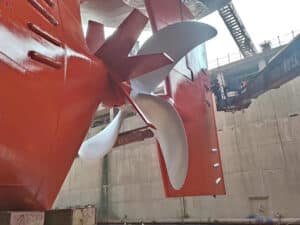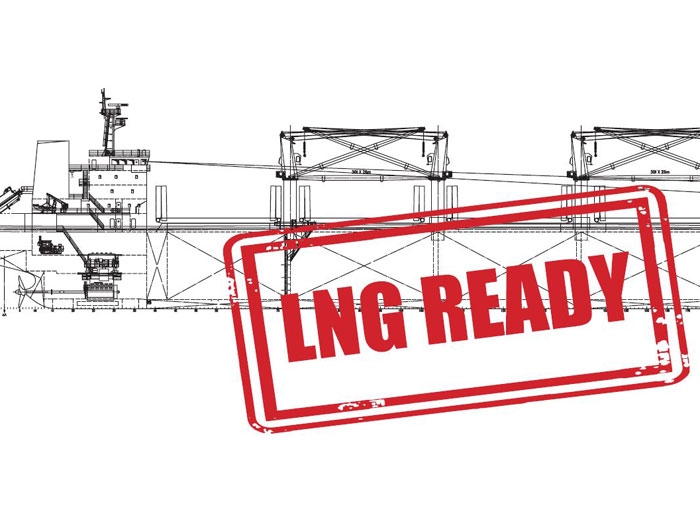
DNV GL introduces “GAS READY” notation
Written by Nick Blenkey
DECEMBER 2, 2014 — So what exactly does saying that a newbuilding is “LNG ready” mean? Classification society DNV GL is about to take away some of the mystery. It is introducing a new class notation, “GAS READY.”
The notation gives owners a useful framework for contracting with the shipbuilder and suppliers when seeking t]o prepare a newbuilding for a potential conversion to LNG operation after delivery. It provides a clear picture of the level of LNG fueled preparedness of the vessel, as well as guidance on the scope of the contemplated work to all involved parties.
“We developed the new GAS READY notation based on the experience we have gained from our LNG Ready service as well as the 50 LNG fueled vessels we already have in class with our GAS FUELED notation”, says Torill Grimstad Osberg, DNV GL Head of Section for LNG Cargo Handling & Piping systems. “This new notation enables owners to ensure that a future LNG fueled version of the vessel complies with the relevant safety and operational requirements, while also being very useful in helping owners specify and quantify the level of investment they are making at the newbuilding stage.”
The basic notation with nominators D and MEc – GAS READY (D, MEc) – verifies that the vessel is in compliance with the gas fueled rules in terms of its overall design for future LNG fuel operations and that the main engine can be converted or operate on gas fuel.
The owner can also choose to add extra optional levels to the newbuilding under the notation. These cover selections such as structural reinforcements and the choice of correct materials to support future LNG tanks (S), preparations for future gas fuel systems (P), certification and installation of LNG fuel tanks (T), and the installation of machinery, which can be converted gas fuel, or which is already capable of burning gas fuel – putting the vessel further along the LNG track and speeding and simplifying a later conversion.
In 2014 the industry hit a significant milestone with over 120 LNG fueled ships in operation or on order worldwide (excluding LNG carriers). The majority of these ships already operate or will be built to DNV GL class.
“DNV GL’s unique LNG Ready service has been in place for over two years and has proven its value in assisting many shipowners, operators, yards and designers in identifying the most attractive compliance option for their ships,” says Dr. Gerd-Michael Wuersig, DNV GL’s Segment Director for LNG fueled ships. “Through a detailed technical and financial feasibility study, the LNG Ready service investigates all the potential options for compliance and fuel cost reduction, uncovers any technical showstoppers, as well as calculating the financial attractiveness of each option. The new class notation GAS READY provides a formalized framework for documenting the compliance option and preparation level chosen, and thereby is a natural extension of the LNG Ready service.”
Over the past decades DNV GL has undertaken extensive research and has implemented many projects world-wide with industry partners covering the regulatory framework, infrastructure and bunkering for LNG fuelled vessels. At DNV GL we have been helping companies and authorities to utilize LNG safely as a source of clean, reliable energy in the maritime industry through a complete set of services for nearly 20 years. With our breadth of services and global outreach delivered through our regional gas and LNG ready teams we have the capability to serve our customers wherever they might be.
Gas Ready – basic notation and extended options (as at December 2, 2014):
GAS READY
D –The design for the ship with LNG as fuel is found to be in compliance with the GAS FUELED notation rules applicable for the new-building, ref. Pt.1 Ch.1 Sec.2 A300.
S— Structural reinforcements to support the fuel containment system (LNG fuel tank(s)) are installed, and materials to support the relevant temperatures are used
T — Fuel containment system (LNG fuel tank(s)) is installed
P — The ship is prepared for future gas fuel system installations: Pipe routing, structural arrangements for bunkering station, gas valve unit space, fuel preparation space if relevant (optional)
MEc — Main engine(s) installed can be converted to dual fuel
MEi — Main engine(s) installed can be operated on gas fuel
AEc — Auxiliary engines installed can be converted to dual fuel
AEi — Auxiliary engines installed can be operated on gas fuel
B — Boilers installed are capable of burning gas fuel
Misc — Additional systems and equipment are installed on board from newbuilding stage.





Leave a Reply
You must be logged in to post a comment.